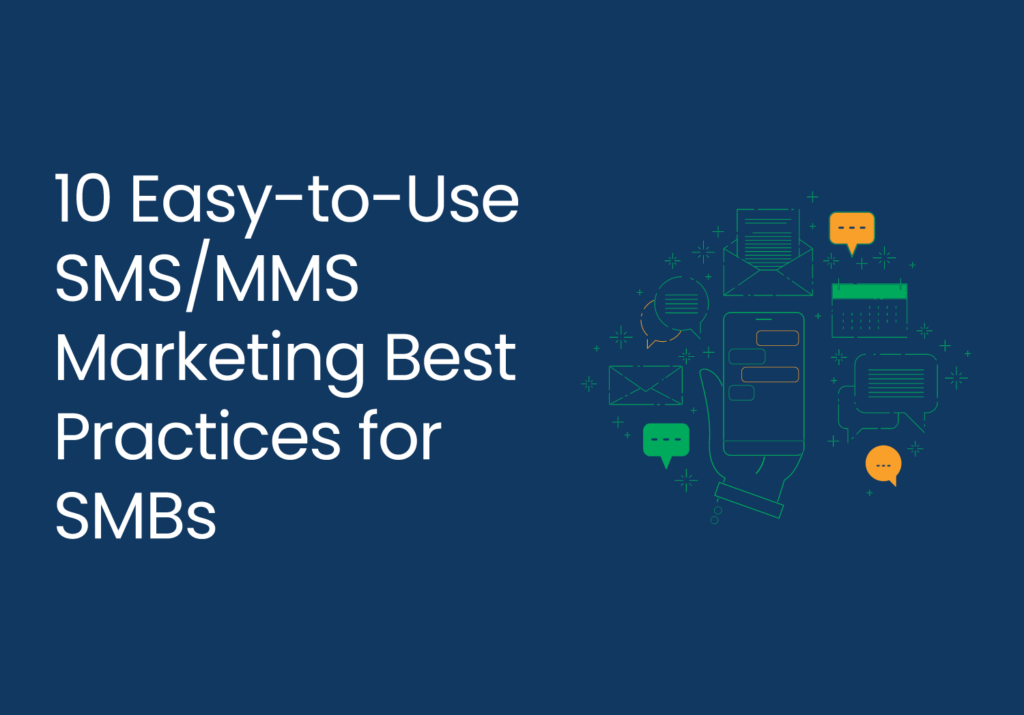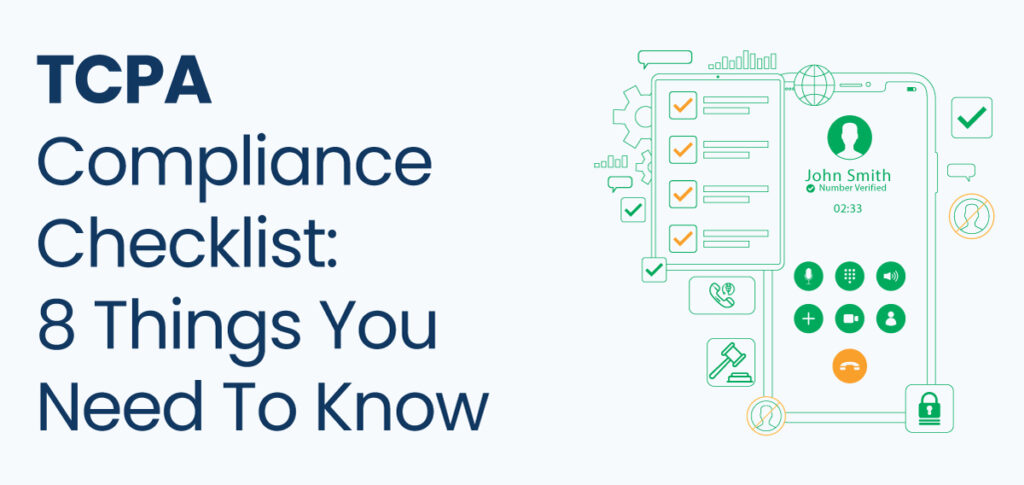Table of Contents
You are on the right page if you have encountered this content while searching for the best SMS/MMS Marketing practices.
We’ll take a tour of understanding SMS marketing, the reasons to integrate it with your outreach efforts/customer service delivery, and the recommended ways to go about it.
According to Semrush Data, while digital marketing is a buzzing word among businesses and marketers with an average of 145k monthly search volume, SMS marketing records a distant 5.5k monthly volume.
You would think that SMS marketing delivers less competitive results than other digital marketing forms; however, it provides the best value for money with a 9.18% higher Click Through Rate (CTR) than other channels.
Some statistics to consider are that 80.5% of your prospects (in 2023) are likely to read texts within 1-5 minutes after receiving them and spend 26 minutes texting compared to 21 minutes per day on calling.
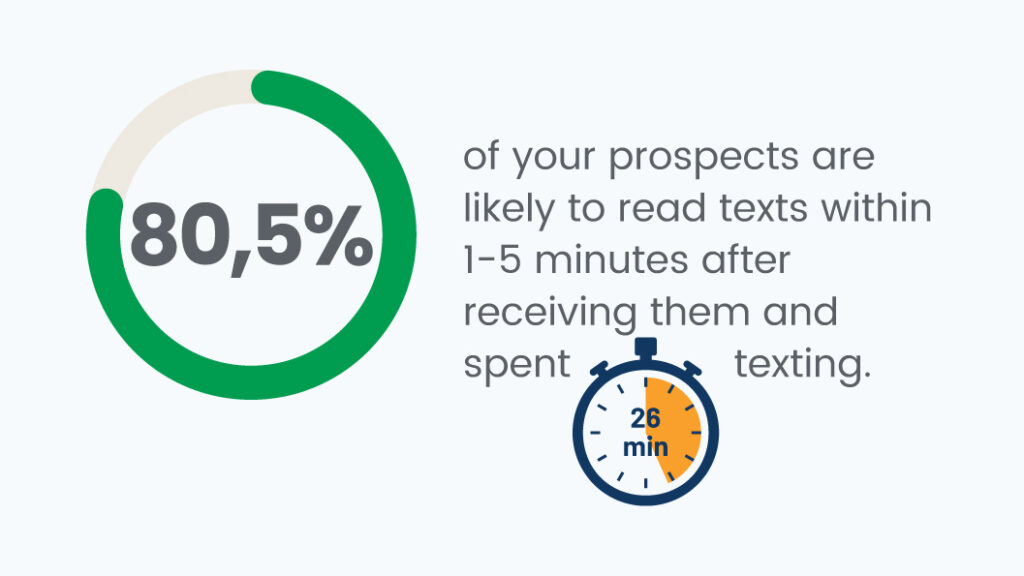
SMS marketing is generally more affordable and cost-effective, costing around $0.01 per message; social media ads can cost anywhere from $0.50 to $10 per click. Of course, these numbers may vary depending on the platform, the campaign type, the quality of the content, and other factors.
Let’s get into the details.
- What is SMS marketing?
- What are the SMS marketing best practices
- List of Best practices for SMS marketing
What is SMS marketing?
SMS marketing is a type of digital marketing that uses SMS (Short Message Service) or text messaging to send promotional messages, updates, or alerts to customers’ mobile devices.
SMBs (small and medium-sized businesses) can use SMS marketing for advertising products, services, events, or other marketing campaigns and customize messages based on customer segments or preferences.
SMS marketing can help your small business connect with customers who are most likely to see your messages because of its speed and a 98% open rate, boosting customer engagement and sales.
Various SMS marketing platforms and tools can help your business create and send SMS messages and measure metrics such as delivery rates, open rates, and conversions.

However, you must comply with legal and ethical rules such as getting consent and protecting customers’ privacy.
Aloware takes care of the legal issues while you focus on acquiring high-quality prospects.
Speaking of compliance, let’s look at SMS marketing best practices.
What are the SMS marketing best practices?
Best practices are some of the critical things to consider when implementing your SMS marketing strategy.
From obtaining customer consent, identifying your company, using concise copies, and incorporating seamless customer service, best practices ensure you don’t get on the blacklist of customers and end up with heavy fines from the Federal Communications Commission (FCC).
Check out the TCPA Compliance Checklist.
The following should make your checklist for text marketing best practices:
- SMS compliance best practices
- SMS shortcode best practices
- SMS notification best practices
- SMS opt-in best practices
- SMS copy best practices
- SMS template best practices
- SMS customer service best practices
- SMS survey best practices
- SMS subscriber growth best practices
- SMS lead generation best practices
SMS Compliance Best Practices
For all the numerous benefits of SMS marketing, if you fail to comply with regulations, your business risks heavy fines and being blacklisted, as stated earlier. Fines range from $500 to $1500 per violation.
Best practices for SMS compliance include the following but are not limited to opt-in rules and respecting opt-outs, obtaining consent, providing terms and conditions, and sending messages at appropriate hours.
- Obtain consent.
- Adhere to texting hours.
- Identify your business.
- Implement opt-out.
- Watch out for DNC numbers.
- Follow the SHAFT rule.
Obtain consent
The TCPA requires you to get consent from consumers before contacting them.
You need written or digital opt-in agreements to send text messages or other outreach types.
You can get consent through campaigns such as emails, e-books, and seminar/conference registrations (online or offline).
Adhere to texting hours
The TCPA SMS compliance allows contacting consumers between 8:00 a.m. to 9:00 p.m. local time.
If your outreach campaign target prospects in different time zones, the local time could be challenging as many contact center systems can’t or don’t look up the consumer’s local time before dialing.
Unless your business sector falls on the list of exclusions, do not send texts outside 8 am to 9 pm (prospect’s local time).
Identify your business
The TCPA requires that you include proper identification on all business text messages. Identificatiıon should consist of your business name and phone number.
Aloware provides a trusted business texting solution that implements industry-standard A2P 10DLC, so you always reach consumers with a verified check-marked business name and number.
Implement Opt-out
Don’t send messages to prospects/customers without an opt-out option.
Besides reporting your business for spam, these customers may file a complaint that would incur heavy fines from the FCC.
Always give consumers the option to stop receiving your messages.
Watch out for DNC numbers
Avoid texting recipients who haven’t consented to receive marketing messages.
SMS marketing falls under the National Do Not Call Registry. Texting people on this list and subscribers who have opted out can get you into a legal battle.
Aloware has partnered with a few vendors to ensure you are up-to-date with SMS compliance laws by scrubbing your numbers against the federal and state-wide DNC registries.
Follow the SHAFT rule
According to the Cellular Telecommunications Industry Association (CTIA) SHAFT (Sex, Hate, Alcohol, Firearms, and Tobacco) rule, you cannot send texts about these five topics as part of your SMS marketing program.
The only exception is for tobacco or alcohol sellers with an age verification system to ensure their subscribers are old enough to receive their deals.
Check out the TCPA compliance checklist.
SMS Shortcode Best Practices
A shortcode is a number with five or six digits a business uses to send and receive customer text messages. On the other hand, an extended code or a toll-free number has ten digits.

SMS short codes help your business engage with prospects memorably through marketing campaigns.
To ensure the effectiveness and success of your SMS campaign, here are some best practices for SMS short codes
- Follow the CTIA guidelines
- Use your shortcode
- Choose a catchy shortcode
- Advertise your shortcode number
- Use SMS lookup service
Follow CTIA guidelines
You must follow the CTIA guidelines and rules to ensure your SMS campaign is legally compliant and respectful of consumers’ rights.
You can find all the needed information in CTIA’s Short Code Monitoring Handbook.
Use your shortcode
In the past, some brands sent messages with the same shortcodes that others used. This caused confusion, spam, and low engagement rates.
Now, major wireless carriers do not allow shared short codes anymore. You need to get a dedicated shortcode for your brand from an SMS shortcode service provider.
Aloware’s business texting solution lets you send mass messages using shortcodes. The shortcode feature allows users to send multimedia messages, including GIFs, emojis, and photos.
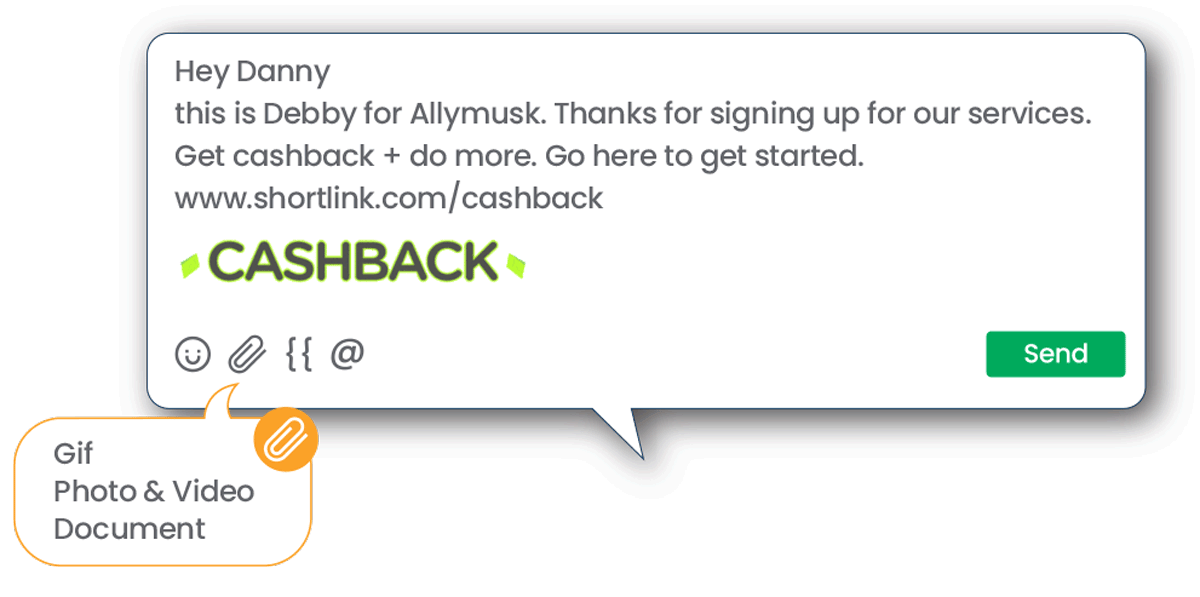
Choose a catchy shortcode
A catchy shortcode should be easy to remember and relevant to your brand.
You can also use a short vanity code that spells out something related to your campaign, such as COFFEE or 411724.
Advertise your shortcode number
You want to get as many subscribers as possible to make the most of SMS marketing. You can do this by spreading the word about your shortcode smartly.
One way is to offer a prize draw that needs an SMS sign-up. Tell your email subscribers or social media fans about the opportunity.
You could also create a VIP club where members get exclusive deals, early access to new products, and more by sending a message to the shortcode.
Use SMS lookup service/directory
A shortcode lookup service can help you verify if a shortcode is available and compliant with CTIA rules before launching an SMS marketing campaign.
You can avoid campaign deactivation and potential penalties by looking up the SMS shortcode list.
Aloware handles this process, so you don’t have to worry about shortcode availability or compliance issues.
SMS Notification Best Practices
One of the critical practices about SMS notifications is to use them sparingly so as not to flood your customers with numerous messages.
According to a report, 60% of subscribers permanently turn off push notifications because they can’t stand the high number of incoming messages.

SMS notification 101:
What is an SMS notification? SMS notification is a short text message a brand sends to its customers for various purposes, such as marketing, customer service, or transactional information. SMS notifications can help your business communicate quickly, conveniently, and cost-effectively with customers.
Always consider the notification value before pushing it out to customers.
Some of the best practices for SMS notifications are:
- Keep your messages precise
- Personalize messages
- Establish an effective schedule
- Use templates
- Adjust your sending based on engagement
- Avoid cross-channel storming
Keep your messages brief
You only have 160 characters to convey your message and capture your audience’s attention. Focus on the essential information and the action you want the customer to take.
Avoid using filler words – uh, uhm, ah, Er, or like, etc.
Add clear and compelling CTAs to keep customers engaged in your marketing funnel.
Personalize messages
Use your customers’ names, locations, preferences, or other relevant details to make them feel valued and engaged.
Also, use a friendly tone to write the notification copy. This establishes a better emotional connection and allows users to feel that the message is exclusively for them.
Example: ChickenBros: Hi Ellen, your birthday isn’t over yet. Here’s a $10 coupon to get the special wings for your special day. Visit xxxx.
Establish an effective schedule
Timing is vital for a successful SMS marketing campaign. You need to know your target audience’s location, schedule, and demographics to send notifications at the right moments.
Use an automated solution to create a smart messaging schedule that makes it easy to reach customers.
Use templates
Work with templates to save time and ensure consistency.
Create templates for common types of notifications such as confirmations, reminders, alerts, etc. You can also use variables to customize your templates for different customers or situations.
Check out How to launch effective text campaigns (10 templates you can use).
Adjust your sending based on engagement
To make your SMS notifications more effective, track how your customers engage and adjust your campaigns accordingly.
You can categorize your customers based on what they like, want, or do and send personalized notifications to each group.
This can boost engagement and deliver better results for your SMS notifications.
Avoid cross-channel storming
Don’t overwhelm your customers with too many messages across different channels. You need to find the right balance.
Use a mix of communication methods, such as SMS, email, and social media, but don’t overdo any one channel.
This can help ensure that customers get relevant information without feeling spammed, leading to better engagement and a happier customer experience.
SMS Opt-in Best Practices
Opt-ins and Opt-outs are non-negotiable with SMS marketing as the TCPA mandates them. Be clear to recipients of their opt-in and opt-out options.
Here are SMS opt-in requirements to keep tabs on when launching your campaigns.
- Send confirmation messages
- Be clear
- Provide an opt-out option
- Monitor Opt-out statistics
- Reconfirm Opt-ins
- Follow regulations
Send Confirmation messages
When customers or prospects opt-in to receive messages from your business, ensure to send them a confirmation message.
The confirmation message is to communicate that they have consented to receive updates and should include your business name and messaging frequency where applicable.
You could also implement a double opt-in where the user replies with a YES or NO to confirm their decision.
Be Clear
Clearly explain what type of messages customers will receive, how often they will receive them, and the cost (if applicable).
Include a statement indicating that data and message rates may apply and clear instructions on opting out if they choose to do so.
Provide an opt-out option
Include clear instructions on opting out of the SMS campaign in every message. Recipients must have an easy way to stop receiving messages if they choose to.
You could use the following lines:
To stop receiving text message communications from us, reply STOP.

Monitor Opt-out statistics
Keep a close eye on your opt-out numbers. If you realize many opt-outs from marketing campaigns, it would be best to re-strategize the campaign.
Another issue could be the messaging. Consider switching CTAs or the relevance of messages.
Reconfirm Opt-ins
For new campaigns, sending reconfirmation messages to consumers would be best.
Customers could have signed up for a previous campaign but may want to avoid receiving messages for another campaign.
Follow regulations
Comply and always stay current with relevant SMS marketing regulations, such as the Telephone Consumer Protection Act (TCPA).
Aloware ensures your business is compliant on all fronts, saving you time to focus on growing your customer base and closing more deals.
SMS copy best practices
SMS copy best practices help you connect with your customers through text messages. You can use them to create clear and engaging messages that boost your brand and sales. For example, you can highlight keywords and phrases to catch their attention.
Here are some tips for SMS copy best practices:
- Use relatable keywords
- Consider using MMS
- Be concise
- Make CTAs stand out
- Link to more information
- Beware of using FREE
- Add an opt-out option
Use relatable keywords
Use different keywords to track the source of your SMS subscribers. This helps you measure the success of your campaigns.
Your keyword should be straightforward and reflect your business and brand. For example, if you run a restaurant, a keyword might be “WINGS” or “WASABI.”
You should also learn which channels are best for attracting new subscribers.
For example, you can invite your Twitter and Facebook followers to text TWITTER or FACEBOOK to your unique short code number.
Consider using MMS
Use the Multimedia Messaging Service (MMS) to make your texts more engaging with images and audio.
For retail or food businesses, it can showcase your products and services better with visuals or gifs.
Aloware business texting integrates with Hubspot to seamlessly use SMS/MMS for your texting campaigns.
Be concise and clear
Send texts that are straight to the point. Avoid using words that the reader could easily interpret differently.
Here’s an example:
It’s time to shoot up yourself in the ******* promotion and stand a chance of winning. Text 34447 to 303030.
From the example, shoot up has different meanings and can be misinterpreted by your audience.
Use simple words and provide genuinely helpful or relevant information of value to recipients.
Make CTAs stand out
You do have a purpose for sending out messaging campaigns. Ensure your anticipated prospect action stands out in the message.
Help your prospects quickly discover the call to action by either boldening text, using numbers, or links.
Example:
Get an Exclusive 80% discount when you sign up with the code WINGS. Visit ****.com to claim your discount.
Link to more information
SMSes are for short messages; hence you sometimes have to sacrifice the details of your campaign for directness and conciseness.
Although you can fit in the necessary information in an SMS depending on the campaign, having a link to a webpage with more explanatory content, terms, and conditions is best.
Beware of Using FREE
Use “FREE” only if it genuinely applies.
Do not use “FREE” to clickbait customers to sign up for your campaign unless the texts and program are genuinely free to the end-user with all supported carriers.
It’s best to use the phrase “Msg & data rates may apply” in any campaign that is not entirely free to the end user.
Add an opt-out option
The need for an opt-out option can’t be overemphasized.
It’s critical to let your customers know they can stop receiving your texts at any time by replying STOP or texting a specific number.
SMS template best practices
SMS templates can help you follow the best practices for your campaigns, save time, and ensure consistency.
For example, an appointment reminder template will always have the date, time, and place. An order confirmation template will link to the product order and maybe a coupon for the following order.
Use templates to standardize your processes and add some personalization to your texts.
- Use personalization
- Use a clear call to action.
- Test your templates
- Keep your branding consistent
- Have dynamic templates
Personalize
Use names, companies, engagement history, or any other relevant information of consumers to add a personal touch to your messages.
Example: Hi Annie, Happy 5th Anniversary! Here’s a 10% discount on your next bill with us. Have a blast!
Use a clear call to action
Use CTAs that motivate the recipient to take action. Examples are Get Your Discount, Book an Appointment, Sign up now, Shop Now, etc.
Example: Hi Danny, this is Debby for Allymusk. Thanks for signing up for our services. Get cashback + do more. Go here to Get Started

Test your templates
Before sending out your campaigns, always test them in-house to ensure they look and read correctly on different devices and operating systems.
Keep your branding consistent
Templates are a great way of building brand recognition with prospects.
Define your brand voice, and consistently use words that make you stand out from every other brand competing for consumers’ attention.
Have dynamic templates
The messaging template for a real estate company may vary from an e-commerce business. Also, the purposes of every message differ as well.
Create templates for Appointment, Confırmation, Sales, or Invitation messages and use them accordingly.
Here are some messaging template examples:
SMS template for customer service
Hi [Client’s name]! Here’s a reminder about your [Service] tomorrow at [Time] with [First Name]. Reply “OK” for confirmation, “CANCEL” if you cannot show up, or call [Phone Number] to reschedule.*
Real estate SMS template
Hi [Client’s name], [Sender’s Name] from [Company] will be your property tour guide on [Date] at [Time]! Please reply to this number if you need to reschedule.
E-commerce SMS template
Hi [Client’s name], thank you for your purchase. We have received your payment for the item [Item Number]. [Business Name]
SMS customer service best practices
With consumers preferring to text over calls, SMS customer service can effectively provide quick and convenient support to your customers.
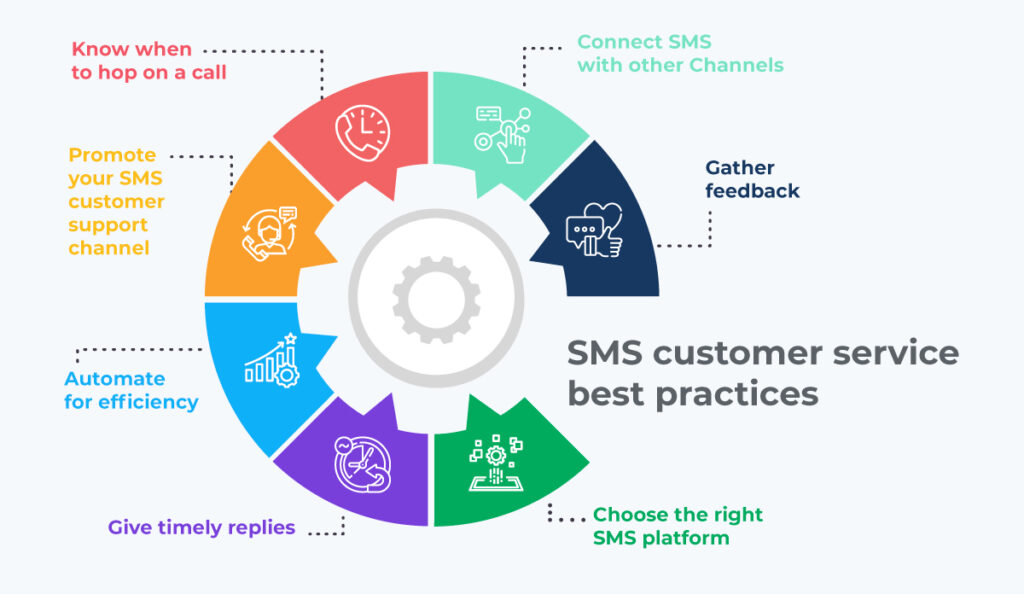
Below are the best ways to optimize SMS for customer service.
- Choose the right SMS platform
- Give timely replies
- Automate for efficiency
- Promote your SMS customer support channel
- Know when to hop on a call
- Connect SMS with other Channels
- Gather feedback
Choose the right SMS platform
The right SMS platform for customer service uses omnichannel to streamline customer interaction for easy tracking and management.
You should be able to follow up on customer complaints and enable internal agent collaboration.
When choosing a platform for SMS customer service, look for one that supports two-way texting, MMS, scheduled messages, SMS templates, automation, compliance guidance, metric tracking, and more.
Are you curious about SMS services? Learn more here.
Give timely replies
SMS requires fast responses; hence your agents need to be hands-on.
Statistics show that consumers open and read messages between 0 to 3 mins.
The best practice would be to reply to texts within a minute. You can send personalized auto-response messages to questions or complaints, letting your customer know you received their message and are working on providing an answer.
Automate for efficiency
Generic requests from customers/prospects should have auto-responses to save productive time for agents.
For example, a customer asking for the whereabouts of their order or the delivery time of a meal can get prompt automated messages, providing accurate answers and delivering customer satisfaction.
Promote your SMS customer support channel
Consumers prefer texting for different reasons, and using other channels to inform them of your SMS support can boost your customer experience.
Know when to hop on a call
Don’t use the wrong channel for the wrong problem. You might make customers unhappy or waste your time.
Help customer service reps know when to call instead of texting. Some pointers for a call could be that the answer is complicated or has many steps, or the customer is upset or emotional.
Connect SMS with other channels
Customer support can use different channels for different purposes.
Make them work well together and meet different customer needs.
A good contact center should effectively combine SMS support services with other platforms to deliver streamlined customer service and save time.
Aloware makes it easy to comply with regulations and simplifies SMS customer services across different platforms with HubSpot integration.
Gather feedback
Using SMS feedback templates, you can ask customers for testimonials.
You can give them the option of sending their feedback as a reply or filling out a short form or survey by clicking on a link. Make it convenient for them to tell you what they think.
SMS Survey Best Practices
Surveys are a great way to understand what your business is doing right or wrong. You can also learn a lot from customers to improve your services or offerings.
SMS survey best practices make getting timely customer and prospect feedback easy. Well-designed, brief surveys provide valuable insights into consumer habits and preferences.
Here are a few things to consider when setting up SMS surveys
- Introduce yourself
- Don’t abuse the use of surveys
- Avoid DNC numbers
- Ensure mobile-friendliness
- Follow up
Introduce yourself
Customers get many spam messages every day. To avoid confusion, start your survey SMS with your brand name.
This allows them to identify you quickly and increases the chances of leaving feedback.
For example, you can ask about service delivery with the text:
“Hi John, this is Jane from TXY Gym. Glad to always have you with us. How would you rate our instructors?
Don’t abuse the use of surveys
Don’t send too many SMS surveys to your customers. You will risk them losing interest and ignoring your messages.
You can only message them more often when they take action, such as buying a product or you require feedback concerning a generally requested service or feature.
Spamming customers with SMS surveys might prompt them to opt out and miss your future campaigns.
Avoid DNC numbers
It’s a common mistake to fire up SMS campaigns without properly checking DNC enlisted numbers.
Aloware ensures you are not a victim of compliance mistakes that could get your business into problems with the FCC.
Before texting prospects, you can scrub your lists against the national and state-managed DNC lists, avoiding DNC numbers.
Check out Understanding the DNC List
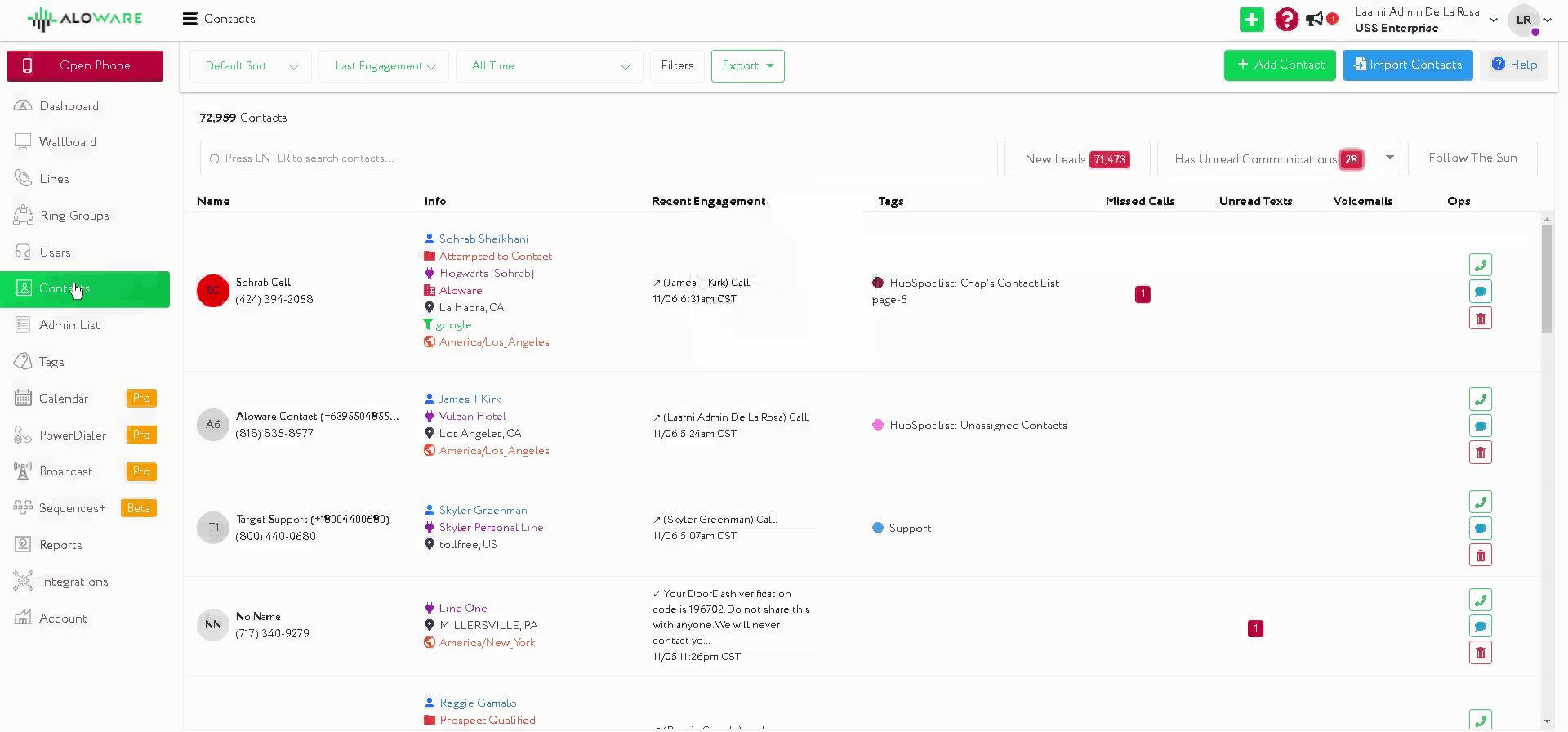
Ensure mobile-friendliness.
Make it easy for customers or prospects to respond to your SMS surveys.
Since you are texting consumers on their mobile, they must be able to open the survey on their mobile phones.
Follow up
Because people are busy, your customers might sometimes see your survey SMS but not have time to respond immediately. They might also forget about it later.
A follow-up survey SMS can remind them about the survey.
SMS subscriber growth best practices
According to reports, 33% of SMS recipients react to CTAs in marketing messages, and 47% make purchases.
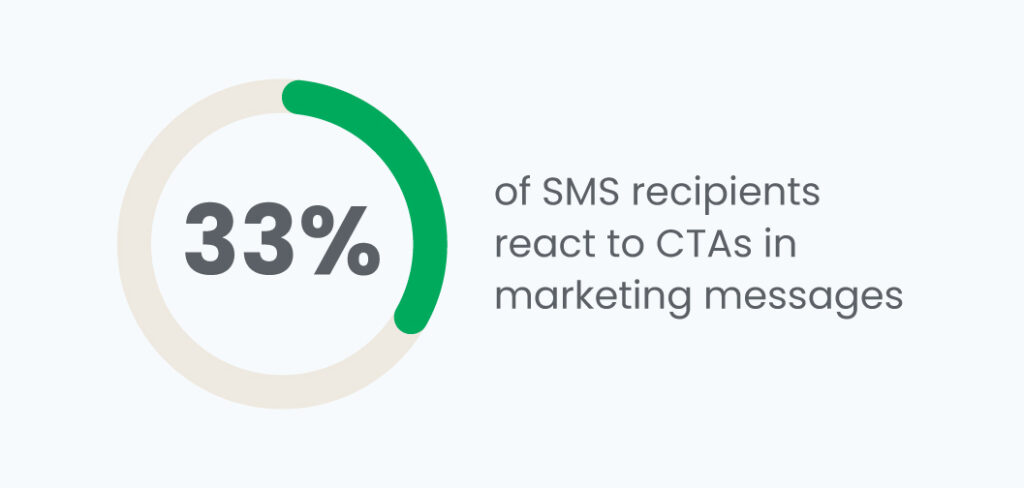
Increasing your SMS subscribers would be an excellent opportunity to improve sign-ups for your services or the purchase of products.
- Use SMS Popups & Offer Opt-In Incentives
- Cross-promote your SMS marketing
- Clarify what subscribers are opting into
- Add SMS opt-ins to your existing signup flows
- Provide exclusives
- Use referrals
- Use advertisements
Use SMS Popups & Offer Opt-In Incentives
Popups can help you get more quality leads for your SMS marketing. However, you need to be careful with implementing this.
To make a popup work, consider its timing, design, and copy.
You can grow your SMS list by using a pop-up builder on your website that offers attractive incentives and a checkbox for users to opt-in to get messages.
Cross-promote your campaign
You can promote your SMS channel via emails or social media.
Give them a compelling reason to agree to receive texts from you. This means you shouldn’t send the same generic messages, offers, or campaigns they get via email/social media platforms.
Make your SMS list exclusive and communicate more personally.
Clarify what subscribers are opting into
Follow SMS marketing compliance laws and tell subscribers what kinds of messages they are signing up for.
You should also share the terms and conditions for subscribing, such as how often you will text them, your texts’ purpose, and any other disclosures.
Defining the messages and sticking to the disclosed information will make customers happy to receive your promotional messages and less likely to unsubscribe.
Add SMS opt-ins to your existing signup flows
You can ask your customers if they want to receive text offers when they sign up for an email or newsletter. This will make it easy for them to opt into text message marketing.
For example, you could have a check box next to the phone number field that says, “Send me promotional offers via text message.” This would help you get more opt-ins.
Provide Exclusives
Make your SMS subscribers feel like true VIPs and keep them interested and loyal.
You can do this by making them feel like they belong to an exclusive club. Offer them the best deals or early access to products before others yet to subscribe. You can also reply to any of their text messages.
This will make more customers want to join your SMS list because they can quickly get the best and exclusive deals.
Use referrals
Referrals are a powerful way to get more customers to sign up because people believe what their friends and family say.
92% of consumers trust referrals from people they know (Nielson). Also, people are 2-10x more likely to rely on word-of-mouth than paid media (Boston Consulting Group).
You can offer discounts or reward points to encourage more people to refer others. This can help you grow your text marketing list.
Here’s a referral text example:
DaveWears: Hi Shane, tell your friends or family about our VIP mobile club and get $30 off your next purchase. Click this link for more info: www.****.com
Use advertisements
Explore other ad options to promote your text marketing and get more subscribers
You can use ads across social media, search engines, magazines, forums, radio, or billboards to grow subscribers.
The ads would focus on prospects texting a particular number to enjoy incentives from your business.
SMS lead generation best practices
SMS lead generation can attract customers to your website or brick and mortar stores.
You can open windows of personal interaction with prospects and gather valuable data with tags/keywords that help customize and improve your marketing approach.
Explore these best practices for SMS lead generation
- Set up triggers
- Create SMS drip campaigns
- Qualify leads
- A/B test your SMS campaigns
- Pay attention to timing
- Include CTAs
- Integrate data with CRM
Set up triggers
SMS triggers send messages to your customers based on specific actions. Consumers can trigger text messages when they abandon sign-up, don’t purchase at check out, or have an anniversary celebration.
You’ll need to review your customer journey to decide which SMS triggers to use. The review could reveal their frequent touchpoints, common issues, or last interaction with your business.
This information can help in the crafting of a trigger message.
For example:
TrendyBox: Hi Mathew, need help to send your first invoice on Trendybox? Here’s a quick guide. You can also talk to an expert here.
Check out Aloware’s Automation Rules and tasks to learn more about triggers.
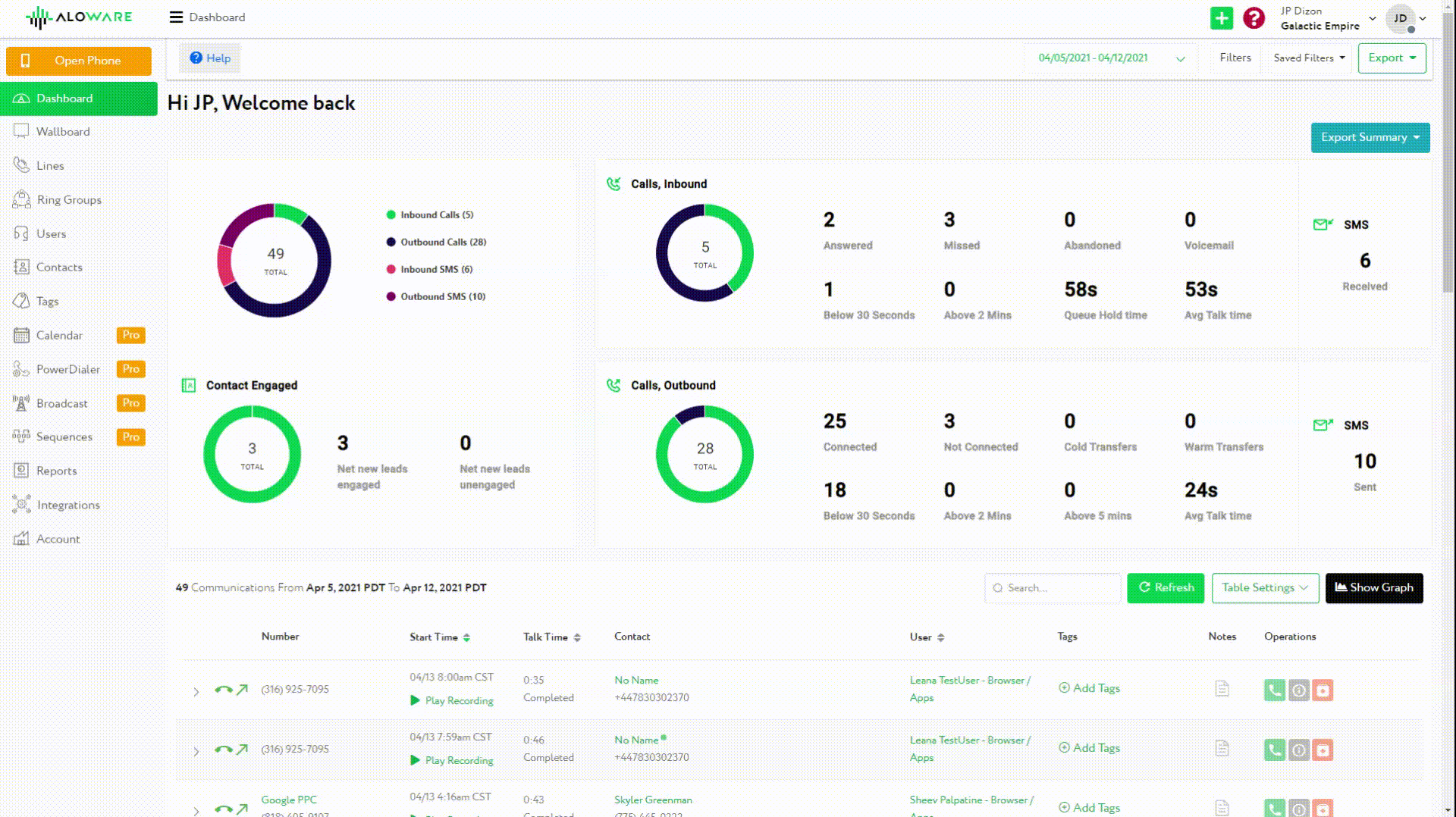
Create SMS drip campaigns
You can set up a series of text messages based on a specific sign-up, with each message timed across days, weeks, or months.
For example, if you have an SMS campaign to get more sign-ups to your fitness club, you can start with an introductory message, briefly mentioning exclusive benefits.
Two days later, you can send another message telling them of a limited and exclusive offer.
A third follow-up message can remind them of the limited offer with added discounts.
SMS drip campaigns will help you provide in-depth value on a topic, increasing the chances of generating leads.
Qualify leads
At different stages of your SMS drip campaign, keep qualifying your leads to optimize how often you contact them and what you offer them.
For example, a customer who just signed up for your service probably doesn’t want to get daily texts, especially if they haven’t seen any value from you yet.
A/B test your SMS campaigns
Test your SMS campaign messages to maximize your lead generation chances.
You can create two messages with the same CTA and monitor the results over time.
See which of them is generating the best CTR. You can make that message the default moving forward.
Pay attention to timing
Timing is an essential factor in lead generation; hence you need to pay attention to when your texts get the most clicks and reads
According to Omnisend, the best time to send an SMS is Thursday-Saturday during lunch and early afternoon (12 PM to 1 PM recipient’s local time) while avoiding rush hour on weekdays.
You should avoid texting on Mondays and during weekday rush hour/commute. The start and end of each month usually have higher SMS conversion rates, except for the 13th, which has a 2.57% average conversion rate.
This may change depending on weekends and holidays.
Include CTAs
Include a clear Call-to-Action (CTA) in every message you send.
Before sending out any text campaign, consider the actions you want your customer to take and ensure your CTA aligns with your lead-generation goals.
It would also be helpful to specify a deadline for an offer as this puts the need for urgency on the recipient’s action.
Integrate data with CRM
The valuable insights you gain on customers through SMS can improve your other engagements with them.
Ensure that data from your SMS leads integrates with your CRM so your reps can access the complete customer details in one location.
Check out Sending Bulk SMS Messages by Integration.
This way, your agents will know how frequently they’ve contacted customers, on which channels, and how the customer has responded.
Final thoughts
SMS/MMS marketing can help you reach your customers directly, increase engagement, and boost sales.
However, to succeed with SMS/MMS marketing, you need to follow some best practices and comply with some rules, as outlined in this article.
Aloware provides an easy takeoff to get you started with SMS marketing and optimize your business texting for improved results and ROI.
Do you need help getting started? Let’s chat.
